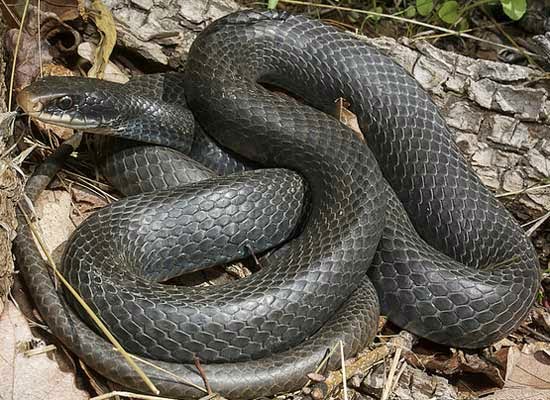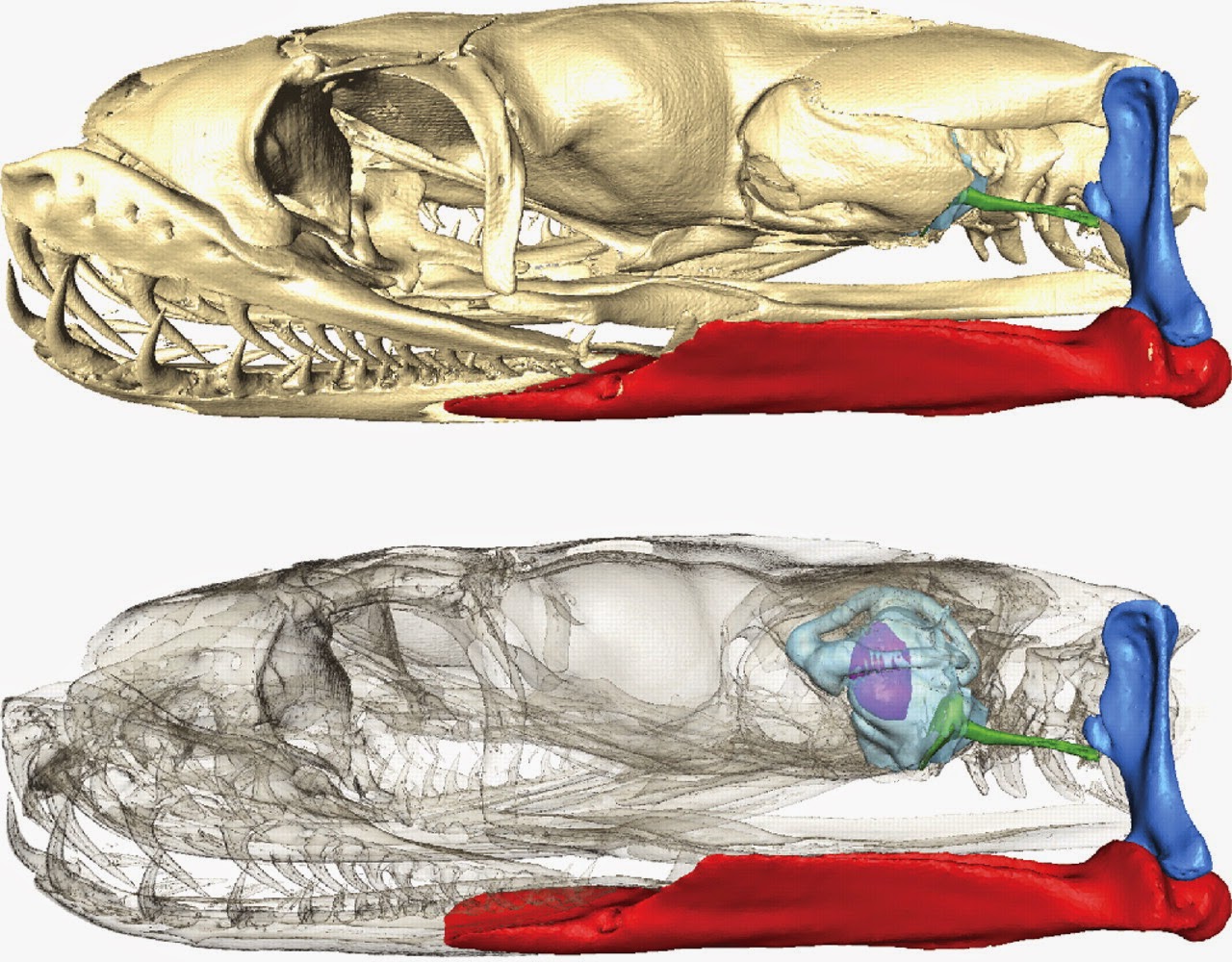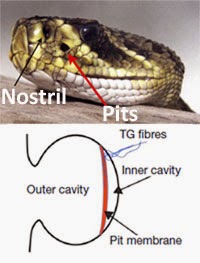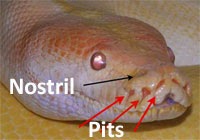Biology
Biology concepts ? thermosensor, sight-hunters, snake hearing, mutation, TRPA1, pit vipers
We?ve come a long way since we started talking about taste sense. We have learned about how TRPV1 capsaicin receptors sense pain and heat. We have also learned that TRPV1 capsaicin receptors have cousins that sense cold - TRPM8 and TRPA1. They may generate pain, and they certainly help to warm us when we are cold.
The non-venomous Southern black racer (Coluber constrictor priapus) is a sight-hunting snake of North and Central America. It?s called a racer because it is quick, reaching 4 mph (1.8 kph) in a very short time. Even though it is a constrictor, it typically doesn?t coil around the lizard, mole, or bird (I said they were quick) that it catches. It prefers to crush them into the ground to suffocate them. Sometimes nature can be a little rough around the edges.
A 2008 study showed that many snakes rest their jaw bones against the ground. The vibrations caused by moving animals are transferred from the ground to the bone, and from the bone to the buried cochlea. The sensation in the brain is a lot like muffled knocks, not unlike the bass that is turned up too loud in peoples? cars.
The amazing thing is that there aren?t any pit vipers or true vipers in Australia. The land of a million weird and painful deaths has nothing to offer in the way of hinged fang venomous snakes. I?m sure there?s a movement to import some.
The explanation is two fold. 1) We said a couple of weeks ago that TRPA1 might sense painful cold on its own, or may work with other TRP?s to respond to very cold temperature. But whichever way it works, it is very similar to TRPV1 for heat sensing and TRPM8 for cold sensing. 2) Remember that in birds, lizards, and many insects, TRPA1 actually senses heat, not cold.
The exception to today?s exception: some non-pit vipers have pits. In terms of evolution, pits evolved once in pit vipers, but they have sprung up several times in boas and pythons. These pits are less sophisticated (no membrane or air chambers), are less sensitive, and are located in different places.
Christensen CB, Christensen-Dalsgaard J, Brandt C, & Madsen PT (2012). Hearing with an atympanic ear: good vibration and poor sound-pressure detection in the royal python, Python regius. The Journal of experimental biology, 215 (Pt 2), 331-42 PMID: 22189777
Gracheva EO, Ingolia NT, Kelly YM, Cordero-Morales JF, Hollopeter G, Chesler AT, Sánchez EE, Perez JC, Weissman JS, & Julius D (2010). Molecular basis of infrared detection by snakes. Nature, 464 (7291), 1006-11 PMID: 20228791
Geng J, Liang D, Jiang K, & Zhang P (2011). Molecular evolution of the infrared sensory gene TRPA1 in snakes and implications for functional studies. PloS one, 6 (12) PMID: 22163322
- Amazing Facts About Ear
Amazing facts about ear 1. Ear is not only the organ of hearing. It helps for our body balancing. You may have noticed feeling dizzy if you have had an ear infection.2. ...
- What Cold Really Looks Like
Biology concepts ? TRPA1, cold sensing, oxygen sensing, proteasome function, hypoxia, normoxia, hyperoxia, phototransduction, optogenetics, methyl anthranilate Last week we learned that the TRPA1 ion channel causes you pain when you are too cold and...
- Why Can?t We Just Go With The Flow? ? The High Cost Of Heating
Biology concepts ? endothermy, ectothermy, poikilothermy, thermoregulation So you are lying in bed, cold and hungry, contemplating living like a monk just so you can have more time to live like a monk (see last week?s post on increasing life span via...
- Your Ears Hear, But Can You Hear Your Ears?
The auditory mechanism is very smalOf your 10 or 11 senses (remember last week? ? sight, hearing, taste, smell, touch, hot, cold, pain, kinesthetic awareness, balance, and maybe proprioception), hearing and sight have the most complex mechanisms. This...
- Why Does Your Telephone Have Two Holes? ? Perspective On Our Senses
We all know that we have five senses: seeing, hearing, tasting, touching, and smelling. Anyone disagree? Wanna put some money on it? @font-face { font-family: "Cambria"; }p.MsoNormal, li.MsoNormal, div.MsoNormal { margin: 0in 0in 0.0001pt; font-size:...
Biology
Sneaking Up On A Snake
Biology concepts ? thermosensor, sight-hunters, snake hearing, mutation, TRPA1, pit vipers
 |
| We have been talking about taste sense for many weeks. I remember a 1975 movie called, A Boy And His Dog, starring a very young Don Johnson. It was a post-apocalyptic story of a guy, his dog, and cannibalism. The best line of the movie? ?Well, she might not have had good taste, but she sure tasted good.? Of course, this isn?t the kind of tastes we have been talking about. |
We have even learned that in rare cases, the cold receptors can be heat sensors, like in chickens and insects where TRPA1 sense hot instead of cold. And this leads us to today?s exception. It?s time to talk about how these relatives of taste receptors help animals to become better hunters and to better sense their environment. Today let?s focus on snakes.
Snakes have a number of ways to catch prey (see this post). Some lie in wait, blending in with the jungle or background until a moving potential dinner catches their eye and moves across their path. Vision is their primary way of finding dinner. As a consequence, most sight-hunting snakes are diurnal (active in daylight).
 |
| Here is the southern black racer. You can see it has big eyes with round pupils so lots of light can enter ? it?s a sight hunter. Many grow to be 5 ft. (1.5 m) long, so they can look intimidating. But they are not venomous and will usually exit the seen if disturbed. |
Other snakes use the combination of scent and taste that we talked about a while back. The Jacobson organ (more scientifically called the vomeronasal organ, VNO) in their mouth can sense the molecules that the tongue pulls in from the air. Like it or not, every organism has molecules floating off of them continuously. Snakes' VNO can pick these up. See this post for more on the VNO.
Some snakes ?hear? their prey coming. True, snakes don?t have an outer ear opening or the small bones that convert sound waves into mechanical waves in our middle ear (see this post for an explanation). But they do have a cochlea, the organ for sensing the vibrations and converting them to a nerve signal. Many snakes can sense the vibrations that their prey generate when they move through the environment using this cochlea and their lower jaw.
Similar to something called bone conduction hearing in animals with ears like ours, vibrations that travel through the bone can also cause movement in the hairs of the cochlea. As we discussed previously, the bending of the sensory hairs of the cochlea are transduced to chemico-electrical signals that travel to the hearing centers of the brain.
 |
| This is from a scientific paper showing the bone hearing of a python. The red is the lower jawbone. The bark blue is the quadrate bone and the green is the equivalent to our stapes bone of the middle ear. The light blue is the inner ear space and the purple is where the cochlea is housed. Vibrations go from red, to blue, to green to light blue, to purple. You can see how sound waves would find it tough to get to the cochlea. |
This was followed by a 2012 study that showed pythons have very sensitive vibratory hearing, but poor sound pressure hearing. Almost all their hearing input comes from the vibrations they sense in the ground or tree, or whatever they happen to be lying on. So be on tip toes, that snake may hear you coming.
But how does any of this relate to a receptor for painful cold and controls mammalian breathing rate? Well, another way some snakes find their prey is by sensing the heat they give off ? even from a few meters away.
Pit vipers are a subfamily of the Viperdae family, called Crotalinae.There are two types of vipers; all of them have hinged fangs, the ones that are folded up into the upper jaw when the mouth is closed, but protrude for striking as the mouth is opened. Pit vipers differ from true vipers in that they have pits (duh!); more about these below. True vipers live exclusively in Africa and tropical Europe and Asia.
In America, where I live, there are a lot of pit vipers. Cottonmouths, rattlesnakes (all 30 species), water moccasins, copperheads ? these are all pit vipers. From southern Canada to Argentina, and from Eastern Europe to parts of Asia, pit vipers are not rare. Eyelash vipers (Bothriechis schlegelii) of South America are arboreal (live in the trees). They have bright coloring, but sit still and wait for their prey to happen by. They strike from above, so they scare the heck out of jungle hikers.
 |
| On the left is the eyelash viper. You can see it doesn?t mean business because its hinged fangs aren?t extended. In the middle is the two-striped forest pit viper. It is protecting it?s young, so the fangs are extended. On the right is a sidewinder rattlesnake. Sidewinders are amazing and will get their own post soon. |
But it?s specific part of the pit viper that we are interested in today ? namely the pit. The pit organ is located between the eye and the nostril, on each side of the snake?s head. It is a hollow pit, so the actual business end of the pit organ is inside the snake?s skull.
The pit is lined with epithelium, but it also has a membrane that is stretched across the base. As a consequence of the location membrane, there are air pockets on each side of the membrane. The trigeminal nerve innervates the membrane and there are thermosensors in the cells of the membrane.
So, the pit organ is a thermosensor that helps them locate prey animals (or predators). But wait you say. Sure, pit vipers may use a thermosensitive ion channel to sense the heat given off by passing prey animals. But we just said they use a COLD sensing ion channel, TRPA1. What gives?
 |
| The pit on a pit viper is located between the nostril and the eye. It would be easy to mistake the pit for the nostril. The cartoon shows the pit anatomy. The air chamber helps cool the air quickly and stops the TRPA1 receptors from firing again. This is so the snake won?t get a residual image of something warm, when the target may have moved in the interim period. |
So maybe it?s not so terribly bizarre that pit vipers use TRPA1 to sense their prey. But before they touch it??? We eat chili peppers and we react to the capsaicin in our mouths and noses. We go out on a summer day, and the heat activates our TRPV receptors in skin and other tissues. We eat something cold (or menthol) and we feel the cold sensations it touches or tissues. But snakes feel the heat of their prey before they eat, from a distance away! There must be more at work.
And there is. The TRPA1 ion channels in the pit organs of pit vipers have a mutated version of TRPA1. Here?s how things work according to a 2010 study that identified TRPA1 as the heat sensor. The pit is a hole with a membrane stretched toward the back. Consequently, there is an air chamber on both sides of the membrane. The membrane is highly vasculature and has the sensitive nerve endings with the TRPA1 channels.
The TRPA1 receptors are always firing, but at a low rate. Neutrally warm objects don?t change the firing rate, but warmer objects (as little as 0.001 ?C warmer than background) will increase the firing rate. The receptor is mutated according to a 2011 study, with 11 amino acids of the pit TRPA1 divergent on only pit-containing snakes. These changes make the receptor so sensitive that it can react to infrared light signals (heat) from several feet away. That would be like our mouth burning over a chili pepper that we walked past in the supermarket.
Since the sensors are spread across the entire membrane, the effect on locating the source is sort of like vision or a pinhole camera. Light passes through the pupil and diverges before it hits the retina. This provides for a larger spread of the ?image? across the membrane and allows for precise two-dimensional map of the target. The difference in heat between the target and the background gives a ?picture? of the object that is warm.
 |
| The Taylor?s Cantil viper will play dead and then strike, but this brings up an important point. DON?T get near a pit viper, even if you are sure it?s dead. The pit is wired directly to the brain and muscles. A dead snake, even one with a severed head, can still strike as long as there is any residual neural electrical flow. People die every year from snake bites from dead snakes. |
The picture generated is also a little like hearing, since the heat will reach one pit earlier or more strongly. By comparing the timing and the strength of the signals from each pit, the distance and direction to the target can be detected by the brain (see this post for localization of sound waves).
Because the heat ?picture? pit vipers pick up is based on the difference between the temperature of target and background, most pit vipers hunt when coolest, so temperature gradient between environment and prey is greatest. Prey will stick out the most.
Snakes can also use the pit more conventionally, as a thermosensor for its whole body. The basal rate of firing will tell the snake when to move to shade if it?s too warm or move to sun if it?s too cold. This is how it regulates its body temperature.
 |
| Pythons and boas can also have heat-sensing pits, but they are 5-10 times less sensitive because of their differing anatomy. The amazing thing is that they evolved the same special power independently from pit vipers, although they both use mutated versions of TRPA1. The nostril has a black arrow and the pits have red arrows. |
Boas and pythons with pits have 3-4 simple pits in their upper lips. They don?t have the suspended membrane for sensing temperature, the TRPA1 sensors are housed within the epidermal cells at the back of the pit.
Next week ? vampire bats and mosquitoes get into the mutated thermosensor act as well.
For more information or classroom activities, see:
Pit vipers ?
http://www.kidzone.ws/lw/snakes/facts11.htm
http://animals.howstuffworks.com/snakes/pit-viper-info.htm
http://animals.pawnation.com/pit-viper-snake-4957.html
http://www.newton.dep.anl.gov/natbltn/600-699/nb681.htm
http://www.biologyofthepitvipers.com/
http://news.nationalgeographic.com/news/2011/07/110713-new-species-pit-viper-china-snakes-animals-science/
https://www.youtube.com/watch?v=lySW2-eYilg
https://www.youtube.com/watch?v=f_G4Q1NAqoA
http://www.nature.com/news/2010/100314/full/news.2010.122.html
http://www.mapoflife.org/topics/topic_312_infrared-detection-in-snakes/
http://www.nsf.gov/news/special_reports/science_nation/infraredsnakes.jsp
http://www.phschool.com/science/science_news/articles/snake_pits.html
Bone conduction hearing ?
http://www.healthyhearing.com/content/articles/Research/Hearing/26145-Do-snakes-have-ears
http://what-did-you-say.org/2012/07/08/out-in-the-wild-hissy-bone-conduction-hearing-could-prevent-a-bite/
http://jeb.biologists.org/content/215/2/ii.full
http://en.wikipedia.org/wiki/Bone_conduction
http://www.hearinglosseducation.com/treatments/direct-bone-conduction
http://electronics.howstuffworks.com/gadgets/audio-music/bone-conducting-headphones.htm
http://www.oticonmedical.com/Medical/YourTreatment/About%20bone%20conduction/How%20does%20it%20work.aspx#.U5dGWIVf13I
http://www.britannica.com/EBchecked/topic/72920/bone-conduction
VNO (Jacobson organ) -
http://chemistry.about.com/cs/medical/a/aa051601a.htm
http://www.neuro.fsu.edu/~mmered/vomer/snake.htm
http://reptilis.net/smell.html
http://chemse.oxfordjournals.org/content/26/4/433.full
http://www.sciencedirect.com/science/article/pii/S187972961100010X
http://www.catbehaviorassociates.com/what-is-the-vomeronasal-organ/
- Amazing Facts About Ear
Amazing facts about ear 1. Ear is not only the organ of hearing. It helps for our body balancing. You may have noticed feeling dizzy if you have had an ear infection.2. ...
- What Cold Really Looks Like
Biology concepts ? TRPA1, cold sensing, oxygen sensing, proteasome function, hypoxia, normoxia, hyperoxia, phototransduction, optogenetics, methyl anthranilate Last week we learned that the TRPA1 ion channel causes you pain when you are too cold and...
- Why Can?t We Just Go With The Flow? ? The High Cost Of Heating
Biology concepts ? endothermy, ectothermy, poikilothermy, thermoregulation So you are lying in bed, cold and hungry, contemplating living like a monk just so you can have more time to live like a monk (see last week?s post on increasing life span via...
- Your Ears Hear, But Can You Hear Your Ears?
The auditory mechanism is very smalOf your 10 or 11 senses (remember last week? ? sight, hearing, taste, smell, touch, hot, cold, pain, kinesthetic awareness, balance, and maybe proprioception), hearing and sight have the most complex mechanisms. This...
- Why Does Your Telephone Have Two Holes? ? Perspective On Our Senses
We all know that we have five senses: seeing, hearing, tasting, touching, and smelling. Anyone disagree? Wanna put some money on it? @font-face { font-family: "Cambria"; }p.MsoNormal, li.MsoNormal, div.MsoNormal { margin: 0in 0in 0.0001pt; font-size:...
